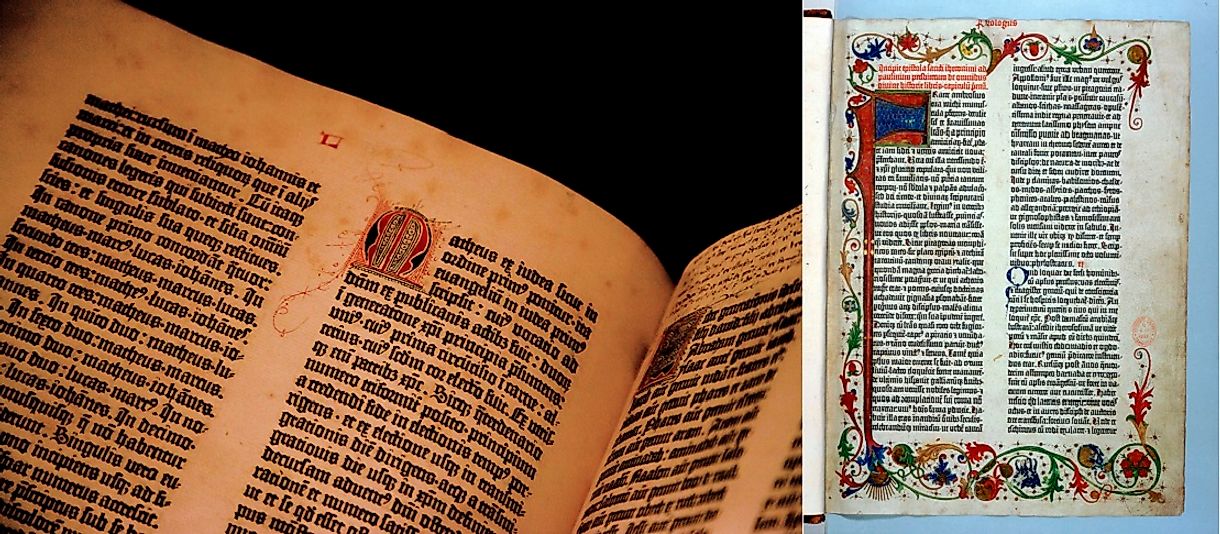What Is The Gutenberg Bible?

5. Development of Printing Technology Leading Up to the 15th Century-
The very first attempts at printing occurred around 3000 BC, when the Mesopotamian culture created rolling printing stamps to imprint designs onto clay. This was continued for many centuries until around 200 AD. Wood block printing was developed in order to print on fabric in East Asia. The influence of Buddhism led to printing on paper in order to produce religious texts. In China, Bi Sheng created a porcelain movable type press. The Chinese alphabet proved too large for this endeavor, however, and the method did not gain popularity. The previously mentioned woodblock technique spread through the Islamic world and made its way to Europe by 1400. Here, it was used to create such items as playing cards and religious images. Until this time, only a few books had been produced because paper was not a common commodity.
4. The Masterpiece of Mainz-
Around 1439 in the city of Mainz in Germany, Johannes Gutenberg created the European movable type press. He also developed the first oil-based ink that was more durable than the previously used water-based inks. The Gutenberg Bible, printed in the 1450’s, was the first major publication and began the European printing age. The first copies of the Gutenberg Bible sold quickly to monasteries, universities, and wealthy individuals all over Europe. Although they were less expensive than manuscript bibles, the printed bible was still too expensive for many middle and lower class individuals.
3. Obstacles Faced by Johannes Gutenberg-
In order to pursue the Gutenberg Bible project, Johannes had to borrow a loan from Johann Fust. In 1456, the two had a dispute over the use of the money and Fust demanded his money back. At this point, the bible project cost more than he had originally planned, and Gutenberg was in significant debt. The argument went to court and the judge decided in Fust’s favor. Thereafter, he was given control of the printing workshop and half of the books it produced. This left Gutenberg bankrupt. However, he managed to start a second, smaller print shop and began printing the bible in another town in 1459. Scholars debate whether this was the work of Gutenberg or not. Meanwhile, Fust continued to use the workshop in Mainz without giving credit to Gutenberg.
2. Significance to Mass Media and the Spread of Christianity-
The Gutenberg Bible is a significant contributor to the modern field of telecommunications as well as the widespread practice of Christianity. Gutenberg’s printing press made mass production possible for the first time in history. By the early 1500’s, around 500,000 books had been printed in a wide range of topics. The availability of books led to decreased prices and increased levels of literacy throughout Europe and ideas could be spread and understood on a much larger basis than previously. Researchers credit the printing press with making the Renaissance, the Scientific Revolution, and the Protestant Reformation possible. When Martin Luther wrote his Ninety-Five Theses, he printed it and handed out multiple copies. Additionally, the Gutenberg Bible provided the model for several future editions which allowed Christians to read the bible in their native language, thus promoting the religion further.
1. Surviving Copies and Legacy -
Today, there are 49 surviving copies of the original Gutenberg Bible, though only around 20 of these are complete copies. Researchers believe that approximately 180 Bibles were originally printed. The Gutenberg Bible is considered to be one of the most valuable books in the world and most are owned by academic institutions. Gutenberg himself, although not very successful in life, is recognized as one of the most influential people in history.











